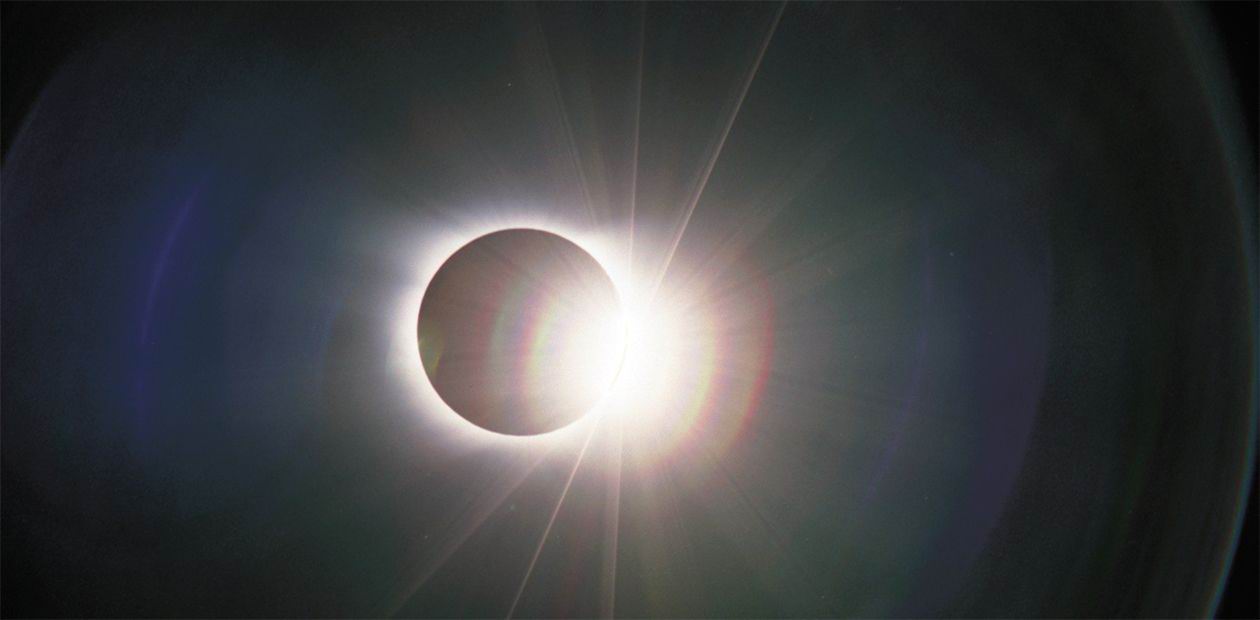Coronation of the Black Sun
March 29, 2006. Fantastic luminosity appeared around the sharp peaks of the mountains, and the horizon started sparkling with yellow and green colors. The darkened enormous bulk of Elbrus was crowned with the sinister black disk of the sun surrounded by a shaggy gray corona…
For hundreds of years, astronomers all over the world have tried not to miss a total solar eclipse. It is only for a couple of minutes, as long as the sun is completely blocked by the moon’s disk, that one can see the solar corona, which consists of rarefied and extremely hot layers of the solar atmosphere.
One would say that it is possible to make good pictures of the solar “nimbus” from satellites as often as it is needed: the satellite trajectory is outside the atmosphere; hence, there is no interference induced by scattered light. It is impossible, however, to take all the equipment necessary for such a survey to outer space since it is very expensive, leaving aside the fact that satellites should not “see” the lower layers of the corona, which are many hundred times brighter than expanding beams: sensitive instrumentation can be damaged.
That is why astrophysicists cannot afford to lose the chance to study this extremely beautiful space phenomenon during the eclipse.
The first eclipse of the 21st century on the territory of Russia occurred on March 29, 2006. “Corona 2006” is the name given by Russian astrophysicists, eclipse hunters, to their expedition to the snow-covered observatory hidden among the icy peaks of Prielbrus’e. The higher you rise above the Earth, the purer and more transparent the air, and the brighter and clearer the photos of celestial phenomena become.
The team that went to see the sun’s coronation in the northern Caucasus consisted of experienced specialists of the Irkutsk Institute of Solar-Terrestrial Physics of the Siberian Branch of the Russian Academy of Sciences. There was also a press photographer and colleagues from Mongolia. Two experiments were planned: estimating the degree of polarization of corona radiation by photographing it through a special filter, and making a clear photograph of the inner part of the corona with fine streamlets of solar plasma.
In winter, the mountain road to Terskol peak is hidden under a layer of snow two meters deep. To reach the observatory, one had to climb a steep path over precipices and snow cornices. A snowstorm started, and the footprints of people going ahead were rapidly covered with snow; the visibility was only several meters. Nevertheless, after six hours of climbing up the expedition arrived at the destination point.
Three- to four-meter snowdrifts surrounded the squatty domes of the observatory buildings; these snowdrifts almost reached the roofs. The snowstorm had ceased, and there was not a single cloud in the sky on the day of the eclipse. The team divided into two groups: one group took pictures from the “Cheget” meteostation (3,000 m above the sea level) on the opposite side of the canyon; the other took photos from Terskol peak (3,200 m). The observation sites were the roofs of the buildings sunk among snowdrifts; the roofs had been providently cleared of snow.
It is impossible to describe a solar eclipse with words. As a “memory” of the wonderful natural phenomenon, the scientists have photographs of the fierce black disk surrounded by dazzling protuberances of the solar corona.
Processing of the data obtained will require some time, but it is already clear now that the shape of the solar corona turned out to be unusual. Since at present the solar activity is decreasing, the solar corona could be expected to have the shape of “Budennyi’s portrait” ( a bald man with a long moustache), as it was poetically described by V. M. Grigor’ev, head of the project, a corresponding member of RAS. At the moment, however, the corona is decorated with long shabby jets more typical of the maximum of the solar cycle.
What is happening to our star and how the picture observed can be explained are questions for the future. Meanwhile, the scientists are planning a new expedition. On August 1, 2008, the band of a total solar eclipse will take place almost at our doorstep: over the Altai and Novosibirsk.
S. A. YAZEV, participant of the “Corona 2006” expedition, doctor of physics and mathematics, leading researcher of the Institute of Solar-Terrestrial Physics of the Siberian Branch of the Russian Academy of Sciences (Irkutsk)
One of the main challenges of the expedition was measuring the polarization of the solar corona during the total solar eclipse.
For this purpose, the Department of Solar Physics of the Irkutsk Institute of Solar-Terrestrial Physics of the Siberian Branch of the RAS had designed a completely automated polarimeter on the basis of the standard portable telescope ASTEL-150. The apparatus uses digital mirror photocameras and polarization optical equipment. The main observations were made from the peak of Azaugichechegetkarabashi (most often called Cheget) at an altitude of 3,200 m. In addition to polarization measurements made by the institute for the first time, the far corona at a distance of approximately three diameters of the Sun from the limb was photographed. This unique scientific material can give information on the three-dimensional structure of the solar corona, its relation to magnetic fields, and on the concentration of electrons at different altitudes.
V. S.PESHCHEROV, participant of the “Corona 2006” expedition, senior reseacher of the Institute of Solar-Terrestrial Physics of the Siberian Branch of the Russian Academy of Sciences (Irkutsk)











